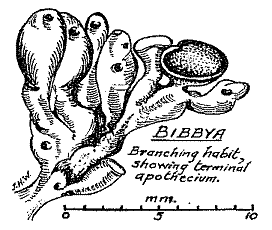Case StudiesBibbya - a genus that isn'tPatrick Bibby had a great interest in lichens and, for a short time, worked on lichens at the herbarium in the Royal Botanic Gardens, Melbourne. Unfortunately Bibby died relatively young and Jim Willis, a colleague of Bibby's noted that one of Bibby's ...
Bibby sent some specimens to the American lichenologist Carrol W. Dodge who replied that this was not a Siphula but a new genus and suggested that Bibby publish a formal description. However, by his death in 1955 Bibby had not published such a description. Willis took up the work and in 1956 formally published a description of the new genus, which he named Bibbya in honour of Bibby, with the one species in the genus taking the name Bibbya muelleri. Along with the formal written description of the new genus Willis included the drawing, reproduced here, which shows a small part of one specimen. On the basis of Bibbya's habitats and some species it resembled, Willis finished his paper with the observation that the...
Rolf Santesson, a Swedish lichenologist, borrowed some specimens of Bibbya and found it to show no differences from Toninia bullata, a species that had initially been named Lecidea bullata and had been described originally (in 1843) from specimens collected in Peru at an altitude of over 14,000 feet. After studying some Toninia bullata samples of Santesson's, Willis agreed with the other's conclusion and published a note to that effect in 1959. Toninia bullata is known from parts of South America to as far south as Tierra del Fuego (where it can be found near sea level). It has also been recorded further north in Mexico and the USA as well as South Africa and New Zealand. In Australia the species is found in Tasmania and the sub-alpine to alpine areas of mainland south-east Australia. The lichen is low-growing, with the thallus composed of numerous short upright growths crowded together as shown in Willis' drawing, so it could easily be overlooked or not even thought to be lichen. In his 1890 paper Wilson wrote:
which is a genus of leafy liverworts! References
|
![An Australian Government Initiative [logo]](/images/austgovt_brown_90px.gif)


